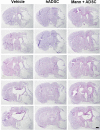Mannitol Augments the Effects of Systemical Stem Cell Transplantation without Increasing Cell Migration in a Stroke Animal Model
- PMID: 32901436
- PMCID: PMC7524994
- DOI: 10.1007/s13770-020-00293-1
Mannitol Augments the Effects of Systemical Stem Cell Transplantation without Increasing Cell Migration in a Stroke Animal Model
Abstract
Background: Mannitol increases blood-brain barrier permeability and can improve the efficiency of systemically administered stem cells by facilitating stem cell entry from the periphery into the injured brain. The aim of this study was to elucidate the neuroprotective effects of a combination of mannitol pretreatment and stem cell transplantation on stroke-induced neural injury.
Methods: The experimental rats were randomly assigned to three groups 24 h after middle cerebral artery occlusion and reperfusion. One group received intravenous (IV) injections of phosphate-buffered saline (vehicle), another group received IV injections of human adipose-derived stem cells (hADSCs), and the last group received IV injections of hADSCs 10 min after IV mannitol injections. Neurobehavioral functions and infarct volume were compared. Immunohistochemistry (IHC) analyses were performed using antibodies against ionized calcium binding adapter-1 (IBA-1), rat endothelial antigen-1 (RECA-1), and bromodeoxyuridine/doublecortin (BrdU/DCX).
Results: PKH-26 labeling revealed no difference in the number of stem cells that had migrated into the injured brain, and hADSC transplantation did not improve the infarct volume. However, neurobehavioral functions improved in the mannitol group. IHC showed higher numbers of RECA-1-positive cells in the peri-infarcted brain and BrdU-/DCX-colocalized cells in the subventricular zone in the mannitol group. IBA-1-positive cell number decreased in the hADSC-only and mannitol-pretreatment groups compared with the vehicle group even though there was no difference between the former two groups.
Conclusion: Combinatorial treatment with mannitol and hADSC transplantation may have better therapeutic potential than hADSC monotherapy for ischemic stroke.
Keywords: Combination; Human adipose-derived stem cells; Ischemic stroke; Mannitol; Pretreatment.
Conflict of interest statement
Authors declare there is no conflict of interest with the manuscript.
Figures






Similar articles
-
The combination of mannitol and temozolomide increases the effectiveness of stem cell treatment in a chronic stroke model.Cytotherapy. 2018 Jun;20(6):820-829. doi: 10.1016/j.jcyt.2018.04.004. Cytotherapy. 2018. PMID: 29776835
-
Breaking the Blood-Brain Barrier With Mannitol to Aid Stem Cell Therapeutics in the Chronic Stroke Brain.Cell Transplant. 2016;25(8):1453-60. doi: 10.3727/096368916X690971. Epub 2016 Feb 15. Cell Transplant. 2016. PMID: 26883984
-
Milk Fat Globule-Epidermal Growth Factor VIII Ameliorates Brain Injury in the Subacute Phase of Cerebral Ischemia in an Animal Model.J Korean Neurosurg Soc. 2020 Mar;63(2):163-170. doi: 10.3340/jkns.2019.0188. Epub 2020 Feb 27. J Korean Neurosurg Soc. 2020. PMID: 32120456 Free PMC article.
-
Human adipose-derived stem cells partially rescue the stroke syndromes by promoting spatial learning and memory in mouse middle cerebral artery occlusion model.Stem Cell Res Ther. 2015 May 9;6(1):92. doi: 10.1186/s13287-015-0078-1. Stem Cell Res Ther. 2015. PMID: 25956259 Free PMC article.
-
Mannitol-enhanced delivery of stem cells and their growth factors across the blood-brain barrier.Cell Transplant. 2014;23(4-5):531-9. doi: 10.3727/096368914X678337. Epub 2014 Jan 29. Cell Transplant. 2014. PMID: 24480552 Free PMC article. Review.
Cited by
-
Conditioned Medium of Human Pluripotent Stem Cell-Derived Neural Precursor Cells Exerts Neurorestorative Effects against Ischemic Stroke Model.Int J Mol Sci. 2022 Jul 14;23(14):7787. doi: 10.3390/ijms23147787. Int J Mol Sci. 2022. PMID: 35887140 Free PMC article.
-
Efficacy of Human-Induced Pluripotent Stem Cell-Derived Neural Progenitor Cell Replacement Therapy in a Vascular Dementia Animal Model.Tissue Eng Regen Med. 2025 Apr;22(3):339-349. doi: 10.1007/s13770-025-00706-z. Epub 2025 Feb 14. Tissue Eng Regen Med. 2025. PMID: 39953271 Free PMC article.
-
Allogeneic human umbilical cord blood for acute ischemic stroke: Phase I clinical trial.Tzu Chi Med J. 2025 May 9;37(3):321-327. doi: 10.4103/tcmj.tcmj_249_24. eCollection 2025 Jul-Sep. Tzu Chi Med J. 2025. PMID: 40741608 Free PMC article.
-
Mesenchymal Stem/Stromal Cell Therapy in Blood-Brain Barrier Preservation Following Ischemia: Molecular Mechanisms and Prospects.Int J Mol Sci. 2021 Sep 17;22(18):10045. doi: 10.3390/ijms221810045. Int J Mol Sci. 2021. PMID: 34576209 Free PMC article. Review.
-
Editing a gateway for cell therapy across the blood-brain barrier.Brain. 2023 Mar 1;146(3):823-841. doi: 10.1093/brain/awac393. Brain. 2023. PMID: 36397727 Free PMC article. Review.
References
-
- Ovbiagele B, Goldstein LB, Higashida RT, Howard VJ, Johnston SC, Khavjou OA, et al. Forecasting the future of stroke in the United States: a policy statement from the American Heart Association and American Stroke Association. Stroke. 2013;44:2361–2375. doi: 10.1161/STR.0b013e31829734f2. - DOI - PubMed
-
- Powers WJ, Rabinstein AA, Ackerson T, Adeoye OM, Bambakidis NC, Becker K, et al. Guidelines for the early management of patients with acute ischemic stroke: 2019 update to the 2018 guidelines for the early management of acute ischemic stroke: a guideline for healthcare professionals from the American Heart Association/American Stroke Association. Stroke. 2019;50:e344–e418. doi: 10.1161/STROKEAHA.118.022606. - DOI - PubMed
Publication types
MeSH terms
Substances
Grants and funding
LinkOut - more resources
Full Text Sources
Medical
